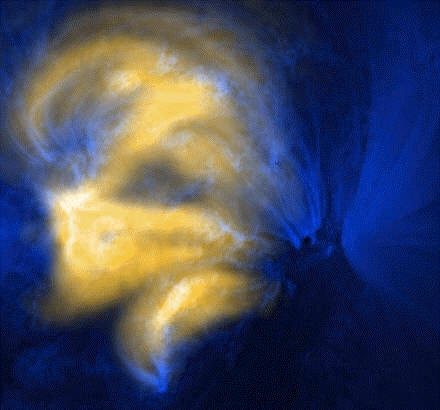Michael Mozina
Banned
- Joined
- Feb 10, 2009
- Messages
- 9,361
However, it is now done. I have seen the flares in white light & EUV, and I have seen all the frames.
Sure, but then my next "concern" is how much time and effort you put into analyzing those three consecutive images? Did you notice that the photosphere changes between the image right before the flare image and the flare image? Did you notice which direction the plasma went? I don't really know. I respect you a great deal on many levels Tim, but you'll have to explain to me *WHY* you interpret things differently.
I have seen all of the images you wanted me to see, and all the frames, so far as I know. I disagree with your interpretation of the images.
Then please explain *why* you think that way.
Indeed, I will say that your reliance on the images is your primary weakness.
Whereas I would say your callous disregard for imagery analysis is your primary weakness. I suppose I'll have to wait to hear you explain why you disagree with my interpretation.
It is as I said before, you have to rely on a subjective interpretation of the images to make your point.
How is that different than any other interpretation? You don't "subjectively" apply your math skills?
There is nothing in the images, not in any frame, which is sufficient to differentiate between your hypothesis and that of mainstream physics,
Well, it's not even all together clear exactly what the "mainstream" position is as it relates to the location of the bases of the loops. Nasa's animations make it clear they expect these loops to originate under the photosphere. LMSAL seems certain they start ABOVE the photosphere. Whom shall I believe based on that image Tim?
It is not enough simply to promote an alternative hypothesis. You must provide a means to simultaneously verify your hypothesis and falsify the competition (in this case, the mainstream physics). I see nothing that does this.
I can falsify LMSAL's position with the three images on that video and they are the one's that put that video together. Likewise I can verify the validity of that animation by the folks at NASA based on the three same images.
You have argued strenuously all along that the EUV images show the photosphere,
No, actually I believe the 1600A images are showing us the calcium plasma surface which is located *UNDER* the photosphere IMO, not over top of the photosphere as LMSAL claims. LMSAL has *EVERYTHING* screwed up IMO as it relates to locations of various layers. They have the calcium mixed with helium in the chromosphere, but if you look at CAII images and Helium images during sunspot activity, helium images don't show any sunspots whereas the CA images typically look a lot like the surface of the photosphere, but not *EXACTLY* the same as the photosphere. In other words there is a similar pattern in both the CAII and white light wavelengths that doesn't show up in He wavelengths.
and it has been one of the major points of contention all along. But now you simply brush all of the aside and admit that the EUV images do not show the photosphere?
I admit that they do not show the photosphere. In fact I defy you to quote me where I claimed they show the same part of the solar atmosphere.
If you are going to say that, is there anything left to talk about?
Sure. I think RC's list is over twenty or so questions long now.
I though that was the point you were trying to make, it is certainly the point you told me you were trying to make.
No, the point I was trying to make is that the bases of the loops are not located above the photosphere as LMSAL claims, but rather they begin far below the photosphere as that NASA animation suggests.
In any case, that the magnetic loop crosses through the photosphere has never been a point of contention; it is well known that they do, and that the loops extend well below the photosphere.
Explain that to LMSAL. They they have the bases of the loops located in the chromosphere.
Well, it clearly starts *UNDER* the photosphere because we see the whole set of loops in that image and we can see where those loops cross the surface of the photosphere and light up the photosphere. The bases of the loops *CANNOT* be located above the photosphere.The real point of contention is "where does the flare start?"
Is it below, in, or above the photosphere?
It begins (sometimes ends) significantly "below" the photosphere as that Doppler image and the heliosiesmology data demonstrates.
Given only the videos & frames you have specified, all 3 alternatives are clearly possible. We need more information, aside from the images, to make a conclusion.
No way Tim. The only location that is feasible is BELOW the photosphere. The ejection of material from the photosphere demonstrates that point. Pay *CLOSE* attention to the surface of the photosphere in the center of those loops in the image before the flare and of the flare. If you're doing your homework "properly", you'll see physical changes in the surface of the photosphere during the flare process.
Last edited:


